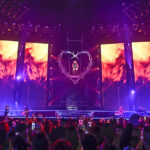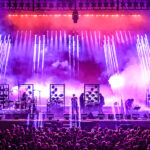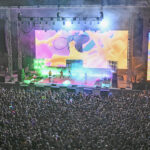Perspectives from Patrick Woodroffe, Mark Fisher and Kevin Bye
Elton John’s Million Dollar Piano, a three-year engagement at The Colosseum at Caesars Palace in Las Vegas, is the artist’s second long-running residency show at the venue. Like the previous residency/tour, Red Piano, a key focal point is Elton’s instrument on stage, in this case a custom-built, million-dollar Yamaha piano that he has named Blossom. The Million Dollar piano has built into it LSI/Saco 3mm high resolution LED screens which feature various visual designs throughout the show. PLSN got the opportunity to discuss the show’s visual elements with LD Patrick Woodroffe, production designer Mark Fisher and lighting director Kevin “Stick” Bye. Patrick Woodroffe, Lighting Designer
Patrick Woodroffe, Lighting Designer
“The effect of Elton’s decision to give us such completely free rein in the design of his Million Dollar Piano show shouldn’t be underestimated. It gave all of us the ability to really think freely, and meant we spent no time or energy in second-guessing the artist. Mark (Fisher) came up very quickly with his beautiful and extravagant design for the set, and that changed very little in concept over the following few months of development. Elton wanted to see nothing until he walked into the room the day before the dress rehearsal, but he did want to continually talk about the music. Very early on, we came up with the arc of the show — where it would begin and what journey it would take the audience on until its finale an hour and a half later. This changed very little over the months that followed, although the songs within it did. But having locked in a sort of unseen narrative it meant that we could start to order the lighting, the effects and the video, even if we weren’t sure exactly where each song would go.
“We then came up with half a dozen key pieces of video that video producer Sam Pattinson went off and commissioned, and with them locked in, we could start to think about a structure to the way that the lighting developed. Each number had its own character, texture and color, these changed very little as the show was developed and we started to program the lighting, both at the pre-viz studio in Las Vegas and then onsite at the Colosseum. Lighting director, Kevin ‘Stick’ Bye and his associate Brandon Stroup were the very solid center of the lighting team.
“In many ways, the venue’s screen was as much of a challenge to work into the show as it was a opportunity. It gave enormous scope for the design, of course, but it also meant that we had to be quite certain that what we put up there was the right thing, and that it completely complemented everything else that was going on stage. Mark was convinced from the start that it was as much a part of the scenery as the giant scenic pieces that sat in front of it, and so for a lot of the show it mimics and mirrors the scenic treatment and the lighting pictures that were placed before it. It’s something we learned on the last big Genesis outdoor show — that a screen that size has to be used as an electronic backdrop as much as for a medium to show moving images. If you get it right, it also gives your audience a breather — time to rest and recharge until they get immersed in the more energetic and dynamic treatments.
“Everything points to the piano, whether it’s the composition of the arched pieces that draw you to the center of the stage, or the composition of the lighting states that all focus towards center. The stage and the lighting are cinematic, not just in scale but also in their format, so it is very much like watching a three-dimensional film. The lighting plot uses darkness as much as light, and although there are moments of great spectacle, there are other whole numbers where the scenery goes into silhouette and the only thing that is lit is the piano and the screen.
“I didn’t bring in a lot of extra lighting, as the system at the Colosseum is pretty impressive before you start to supplement it in any way. Most of what we added was to light the scenery from positions that didn’t already exist — on the back of the moving scenic pieces, for example, or fixed to the base of the rear screen. We used a handful of Sharpys, a fixture that had only just come out when the show was conceived, and these were very effectively used.
“This was a hugely rewarding job on so many levels. Keith Bradley, Elton’s tour director of many years, made us welcome, as did all his longtime crew. Stick Bye, Elton’s trusted lighting director, kept the whole thing together. Demfis Fyssicopulos programmed the show with delicacy and style. I’ve already visited the theater a year after we opened, and the show feels as fresh and interesting as it did on opening night.”
 Mark Fisher, Production Designer
Mark Fisher, Production Designer
“When Patrick [Woodroffe] and I met Elton for lunch for our first meeting about the show, I already had a very clear idea of what the set design should be. Elton is the King of Rock ‘n’ Roll, a position that embodies everything from the extravagant decadence of his most extreme stage costumes to the stripped down piano blues of his simplest songs. Patrick and I wanted the show to reflect the whole range of his talent. To me, this meant starting the show by presenting Elton as the Sun King in a stage environment that was more over-the-top than anything in Versailles, richer in symbolism than anything in the great Italian churches, all warped and twisted into the most Baroque distortion I could invent. The big idea being to strip away the extravagant decorations during the show so that the finale would leave only Elton and his band alone on an empty stage with only the huge Colosseum LED screen for company.
“The content that Sam (Pattinson) created takes over pretty much after the second song. But my big idea for the walk-in look was that the entire stage should be a huge, distorted, gilded Baroque sculpture. To that end, the image on the LED at the top of the show is a projection of a sculpture that was carved to be part of the scenic composition. It features sun rays and frozen swirling draperies after the manner of the Ecstasy of Saint Teresa by Bernini in Rome. It’s a fantastic backdrop, and Patrick has balanced the lighting on the rest of the set so well that most of the audience do not clock that it is a video image. Which makes for a nice surprise as Sam begins to deconstruct the picture as the show moves into the first chorus.
“It seemed obvious to me from the start that the King of Rock ‘n’ Roll should be depicted in the Palace of the Sun King. The world of the High European Baroque, which I shamelessly pillaged, collaged and distorted, is the natural visual language with which to express the qualities of Elton’s performance. Elton’s stage set is no exception, with some piano keys forming the edges of the cornices and Elton’s King Charles spaniels featuring in decorative panels at the bases of the Barleycorn columns.
“The key people in my world that I want to thank, apart from Keith Bradley, who deserves to be congratulated for keeping his nerve throughout, are Barleycorn columns. He did all of the legwork necessary to get the show delivered, coordinating with Brian Levine and Jacqui Pyle. Jacqui is a scenic sculptor based in the U.K. I have collaborated with her on projects for 20 years, including U2, The Rolling Stones and many other acts. She created large clay maquettes from my hand sketches and Rhino models; these were laser-scanned and then enlarged to full size under her supervision by The Scenic Route Inc. in California. Brian Levine, the project manager at Tait Towers, worked with Ric and Jacqui. He masterminded the delivery of the project, which included supervising and coordinating all of Tait’s fabrication and installation work with Jacqui’s sculptures and Ric’s art direction.”
Kevin ‘Stick’ Bye, Lighting Director
“The original show was programmed on a grandMA 1, so it became necessary to convert and reprogram it on a grandMA2. This made the most sense, since that is the platform at the Colosseum that LD Yves Aucoin uses on the Celine show, as well as Peter Morse on the new Shania Twain show. So now all shows at the Colosseum are on the same page, console-wise, which make the turn-around a lot easier to manage. I also use the grandMA2 on Elton’s touring shows I direct, so it is nice to have that consistency. I have been triggering media and cameras with the console for years, so this was nothing new. We use a D3 on the Million Dollar Piano show.
“The Million Dollar Piano show is completely different from our last outing — such a gorgeous show to see! I’m a pretty lucky guy to have been around such a great production team for so many years! Many thanks to A.C.T Lighting for show conversion help. And I can’t say enough good things about Braden Stroup. He is the unsung hero, both on this and our touring shows. Braden is key in that he is a brilliant programmer and knows his way around the console, media server and networking systems. We are lucky to have him in our camp!
“It was an absolute pleasure working with Patrick on this project, such a lovely guy. He had a very clear vision going in on what he wanted to achieve, and the whole process went really well. And of course, his collaborations with Mark are renowned. The look of the show is quite stunning.”


